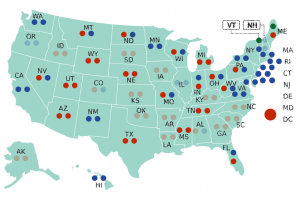By Alfredo R. Santos
La Voz de Austin
On June 4th, 2011, I went to a rally at the Texas State Capitol to help call attention to the fact that public education is under attack in Texas. As I stood in the rotunda of the Capitol shouting slogans and singing a modified version of the “Eyes of Texas Are Upon You,” I notice a little girl with her mother who was also singing.
When the crowd broke into chants and punctuated the air with their fists for emphasis, this little girl, in her uncoordinated manner, did the same. She really seemed to be enjoying herself. I scanned the crowd and saw other young protesters with their parents who were also shouting and singing.
Allen Weeks, the organizer of the Save Texas Schools movement and the rally inside the capitol, called people forward to share their concerns about education. After a couple of adults spoke, the little girl that had been chanting raised her hand. Allen called her to the center and in the words of an innocent 10 year old child, she shared, in a calm voice,
her concerns for school, as well as why she wanted her teachers to come back.
This little girl did not understand the complexities of what politicians do, nor she did not try to explain processes or connect the dots. Instead, she told everyone how she felt. She simply shared her feelings about her school and her teachers.
This little girl spoke from the heart and spoke volumes to why a good public school is essential for her development and hopes of what tomorrow might bring.
As I absorbed the moment along with all the other adults present, I realized that the debate about public education is not really about money. It’s not about funding formulas and equity issues. I believe the current debate regarding public schools has to do with how one sees the future.
There are those elected officials who have read the latest Census figures, studied the bar graphs and charts and then slowly closed the report. These same elected officials have taken a look around the state and noticed there sure are a lot of students in school with last names like, Avalos, Cotera, Hernandez, Pulido, and Zuniga.
The question that drives some of these elected officials who like to invoke a Tea Party allegience to fiscal austerity, is whether or not they want to help educate people who don’t look like them. It’s not that complicated.
As the state turns increasingly brown, there are those who are becoming increasingly worried about what the future will look like. Add to this, the sensationalism from the folks at FOX television who showcase the many ingenious ways desperate people find to get around, over or under a multi-million dollar fence on the border, and the politicians are swamped with telephone calls from constitutes who feel they are being invaded (Pass the guacamole, please).
There was a time in Texas when Mexican kids went to Mexican schools, Black kids went to black schools and Anglo kids went to the “regular schools.”
When you step back and take a look at how Texas has changed or been forced to change over the years? The school house has often times served as the battleground for these issues.
In the 1960s and 70s, students and parents who wanted improvements in the public schools staged massive walkouts. Some lasted two days and some lasted two weeks.
Some, like the 1969 Crystal City ISD walkout, lasted four weeks.Where as, the 1970 Uvalde CISD walkout lasted six weeks. But it was the walkout/boycott in San Angelo, Texas, done by Mexican American parents who wanted their kids to go to school with the
Anglo kids, that lasted the longest.
The school board told the parents that they would build them their own brand new schools. The parents said “no,” because they wanted their kids to go to school with the kids who had last names like, Taylor, Moore, Smith and Jones.
The local school board denied their demand and as a result, the parents kept their kids out of school for four years! For four years the parents held firm.
What year did this take place? 1910.
For more than 100 years, the struggle to get a good education has been an ongoing battle in Texas. Yes, there have even been lawsuits.
In 1930, Mexican American parents in Del Rio, Texas went to court over the two rooms that were to be the “Mexican school.” In 1948, in Bastrop, Texas, parents went to court over segregated campuses with minimal facilities and a curriculum that was limited to vocational training.
Time and time again, parents have had to stand up to defend their children from those who understand that once you allow a child to become educated, you cannot take
away that knowledge, or the wisdom that comes along with it. You cannot uneducate a person who has learned how to read, who has learned how to think for themselves and who has learned how to question authority.
Today, much like the way the parents in San Angelo, Texas believed that the doctrine of “separate but equal” was not right, parents are finding out that a majority of Texas law- makers are not only trying to change the essence of the public schools, but that they want to do it without even a public debate.
These politicians have a very different view about the future and who should be a part of it.
Back to the rotunda: the other thing I heard people discussing at the rally was how, for many of them, it was the first time they had ever come to Austin to sing and shout and protest.
A few said they never knew they could carry out this kind of activity. But what the politicians should really be worried about, are those people who said they actually liked
the feeling of being in the Texas State Capitol and having their voices heard.
Alfredo R. Santos is the editor and publisher of La Voz de Austin.




